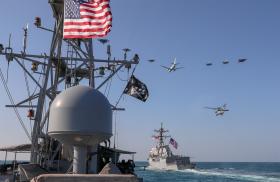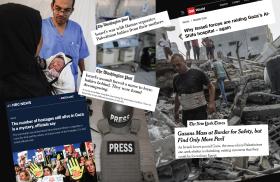

To meet emerging threats and ensure its continued relevance, the Iranian army is seeking to become a quick-reaction force, but institutional and budgetary constraints could still prevent dramatic change.
Despite shows of public consensus, Iran's postrevolutionary decades have been rife with internal competition, including in the military ranks. In particular, clashes of interest have occasionally flared between the Islamic Republic of Iran ground force (IRIGF) -- the land arm of Iran's national armed forces, or Artesh -- and the Islamic Revolutionary Guard Corps (IRGC).
As outlined in Article 143 of the Iranian constitution, the national armed forces are tasked first and foremost with defending Iran's independence and sovereignty, but they are also responsible for protecting its "ruling Islamic Republic." Meanwhile, the seemingly more rewarding job of protecting the Islamic Revolution and its achievements is entrusted, by Article 150, to the revolutionary armed forces -- the IRGC and Basij Organization -- explaining their more extensive political influence, better personnel benefits, and significantly larger annual budgets. In fact, the IRIGF budget for the Iranian year ending March 21, 2018, was one-third that set aside for the IRGC and Basij and their expeditionary operations. Such disparities have been primary sources of imbalance and, at times, discord between the two military arms, even as administrations and commands have changed.
One nominal alteration in mission was enacted in 1987, when the Artesh also assumed the "reserve role" of "cooperating with the IRGC in helping Muslims and other Muslim-friendly suppressed nations defend against military threats and aggression, as deemed necessary [by the Supreme Leader at the time]." Since 2015, the Artesh has carried out such a task in Syria, where individual advisor-observers from the elite 65th Airborne Brigade, Iran's special forces advisors, were sent under the auspices of IRGC's Qods Force. Yet such limited realization of the expanded role suggests that, thus far, the IRIGF has stayed largely clear of the IRGC's regional adventures. Even occasional IRIGF operations in eastern or northern Iraq, such as the August 2014 attempt to break the siege of Amerli, were brief and supportive in nature.
Now, however, top Iranian officials, including Supreme Leader Ali Khamenei and Gen. Mohammad Bagheri, who heads the Armed Forces General Staff (AFGS), perceive menacing hybrid threats along, across, and beyond Iran's borders, explaining their call over the past year or so for a more flexible IRIGF with expanded responsibilities, including that of collecting intelligence beyond Iran's borders, similar to the IRGC role. In 2016, Khamenei instructed the armed forces to defend Iran's "borders of national security," ostensibly implying something beyond Iran's geographical boundaries. For an army tailored to engage in defensive warfare against conventional adversaries, however, fighting proxy wars on a par with the IRGC, such as in Syria, requires preparedness and specialized training on offensive tactics.
Organizational Changes
Given the needs just described, General Bagheri, upon his appointment to lead the AFGS in June 2016, directed the IRIGF top brass -- handpicked for their regime loyalty, above all -- to accelerate a six-year-old force-redistribution plan. The initiative, called Samen al-Aeme, was modeled on close examination of the U.S. brigade-combat-team concept and was intended to improve the army's flexibility and mobility. The military thus sought a better matchup against emerging hybrid or multidimensional threats, as well as an injection of revolutionary and religious zeal, which is ever flagging.
Guided by this vision, the new IRIGF commander, Gen. Kiomars Heidari, who replaced Gen. Ahmad-Reza Pourdastan in late 2016, began overhauling the force. He reorganized each of the eleven IRIGF divisions into three independent mobile-combat brigades under a simplified chain of command, while retaining the divisional staff superstructure. Thereafter, he oversaw the creation of five regional headquarters to lead the army's divisions. These divisions were, in turn, elevated to "operational headquarters," all empowered to make decisions within their local areas of jurisdiction. The independent brigades now answer to the operational headquarters, mirroring somewhat the IRGC's concept of decentralized operations.
The IRIGF commander and his staff can directly engage in command and control of individual brigades, if necessary, through a newly formed infrastructure called "Velayat Command Headquarters." Once in place, this entity will purportedly allow top commanders to direct orders and intelligence to the lowest tactical echelons. According to Ahmad Vahidi, who heads Iran's Defense Strategy Research Center, such organizational and doctrinal changes are meant to enable the fighting of conventional or asymmetric, and hybrid or proxy, wars with a smaller, more efficient force.
According to The Military Balance 2017, an annual report by the International Institute for Strategic Studies, the Iranian army today stands at around 350,000 members, compared to about 130,000 in the Pasdaran (IRGC) and about 1,000,000 in the Basij. Despite recent efforts to boost the IRIGF with new arms and equipment, it still lags seriously, often forced to patch up existing equipment ad hoc with locally produced parts. The IRIGF's new emergency investment, begun in late 2016, has so far delivered limited additional improvements. After years of laboring under international sanctions, however, Iran's army aviation and helicopter maintenance operations finally received funding last year to return the grounded U.S.-made Huey, Chinook, Jet Ranger, and Cobra helicopters to service at a rate of about ten airframes per year. A few are said to have also received night-vision and targeting upgrades. In the past, Tehran has claimed that its attack helicopters had penetrated as deep as forty kilometers into Iraqi airspace to hunt for Islamic State militants approaching Iran's eastern borders.
Iran still faces a shortage of helicopter airframes and trained pilots, likely necessitating action on both fronts. To acquire the needed airframes, Tehran is now in talks with Moscow about assembling several Russian models in Iran, including the Kamov Ka-62, a transport helicopter capable of carrying up to fifteen soldiers.
Quick-Reaction Force
Another area likely to be addressed is an existing overreliance on cheap conscripts. Although the Artesh cannot afford to go completely professional, its leaders want to make gradual organizational changes that reduce the proportion of conscripts. They also aspire to form new "quick-reaction brigades," to increase the mobility of existing infantry units by equipping them with easier-to-maintain light wheeled vehicles, and to encourage more active participation of Army Aviation, known as IRIAA. In an evident act of direct competition, the IRGC announced similar plans on April 20, preceded by the creation of its own army aviation section in early 2016. The IRIGF, for its part, ultimately wants to be able to respond to any flashpoint along Iran's 5,440-kilometer land borders within four hours -- an ambitious goal, to be sure -- joined by offensive missions within a self-declared 40-kilometer "red" buffer zone beyond its borders.
At present, the Iranian army has eight special forces (Takavar) brigades and two airborne special operations brigades. Moreover, officials announced that two new quick-reaction brigades would be formed within the current Persian year. While Takavar brigades include conscripts who learn basic parachuting skills and are trained to fight in a variety of environments, the airborne -- now "quick-reaction airborne" -- brigades consist mainly of professionals who receive more extensive training in unconventional warfare, airborne assault and infiltration tactics, diving, skydiving, hostage rescue, sniping, and so forth. In 2015, a dedicated quick-reaction school was inaugurated near Tehran, with the first class graduating in 2016. In addition, almost all existing Takavar units are reportedly slated to undergo refresher training so that they can ultimately assume quick-reaction roles. The quality standards for this training are unknown, but the units involved have been promised better equipment and, for the first time, foreign-language instruction.
Organizationally, the IRIGF wishes to transform as many of its thirty-four combat infantry and mechanized/armor brigades as possible into professional and well-armed mobile-assault brigades to fulfill both defensive and offensive roles, as directed by the Supreme Leader. Such a move also accords with Iran's newly implemented "Law on the Sixth Five-Year Economic, Cultural, and Social Development Plan," covering 2016-21, and the Artesh's supposed new doctrine.
Financial Constraints
The national armed forces, or at least their ground and air components, have benefited less than the IRGC and Basij from recent budgetary increases, which this year amounted to 13 percent, in addition to a further 4 percent set aside exclusively for the IRGC and missile program. As a result, they continue to rely on lightly trained and equipped manpower, with most personnel conscripted for twenty-four-month periods. Even their professional cadre struggles with motivation, as admitted recently by the new IRIGF commander. Such a lack of motivation, which stems mainly from the favoritism granted to the IRGC and to the resulting inadequate working conditions, recently spurred the creation of a task force dedicated to tackling the problem. Yet all such plans will require significant funding beyond the Artesh's $2.3 billion budget (compared to a $7.65 billion publicly disclosed budget for the IRGC/Basij). Even current IRIGF plans to sell off or redevelop some of its properties are not expected to cover the costs, at best only helping pay wages.
The Artesh has thus been compelled to find new sources of revenue. It has done so, in particular, by getting involved in the airline business, purchasing majority stakes in Caspian Airlines and forming Meraj Airlines -- both under international sanctions for aiding the Syrian regime -- and by trying to follow in the lucrative footsteps of the IRGC's Khatam al-Anbia Construction Headquarters (KACH) and forming its own construction concern, known as Qorb Headquarters. Qorb's powerful IRGC rival, needless to say, has greatly overshadowed it, and the Artesh entity has been limited to subcontracting for KACH. At the least, Qorb is expected to secure the Artesh's own construction projects, said to include twelve new barracks around the country. Yet a lack of financial transparency will prevent public knowledge regarding how much of this revenue ends up funding procurement and upgrade efforts and how much is pocketed.
Conclusion
To summarize, the Iranian national ground force is reorganizing with the goal of becoming more responsive and mobile, embodied in the creation of independent quick-reaction brigades. The effectiveness of such measures is open to question, however, considering logistical hurdles, a dependence on uncommitted conscripts, and aging equipment that indigenous industries have not been fully able to replace. Added to this are funding constraints, despite an increase of at least $1.3 billion to the current defense budget, most of which is expected to go to priority IRGC-run missile projects. Yet, in a first since 1989, Brig. Gen. Amir Hatami, who will soon take over for Hossein Dehghan as defense minister, comes from the Artesh ranks, and it remains to be seen whether a slightly larger share of funding and equipment for the Artesh will follow.
These shifts notwithstanding, efforts to broaden the Artesh profile and grant it offensive roles are not likely to alter the balance of power in Iran's military landscape. The national armed force, according to this view, will retain its inherently cautious and defensive position and remain mostly on the sidelines. Meanwhile, the IRGC, its Qods Force, and the Basij will continue to drive Iran's offensive posture both at home, dealing with popular dissent, and abroad, in support of Iran's proxy wars.
Farzin Nadimi is a Washington-based analyst specializing in the security and defense affairs of Iran and the Persian Gulf region.



